Affiliate links on Android Authority may earn us a commission. Learn more.
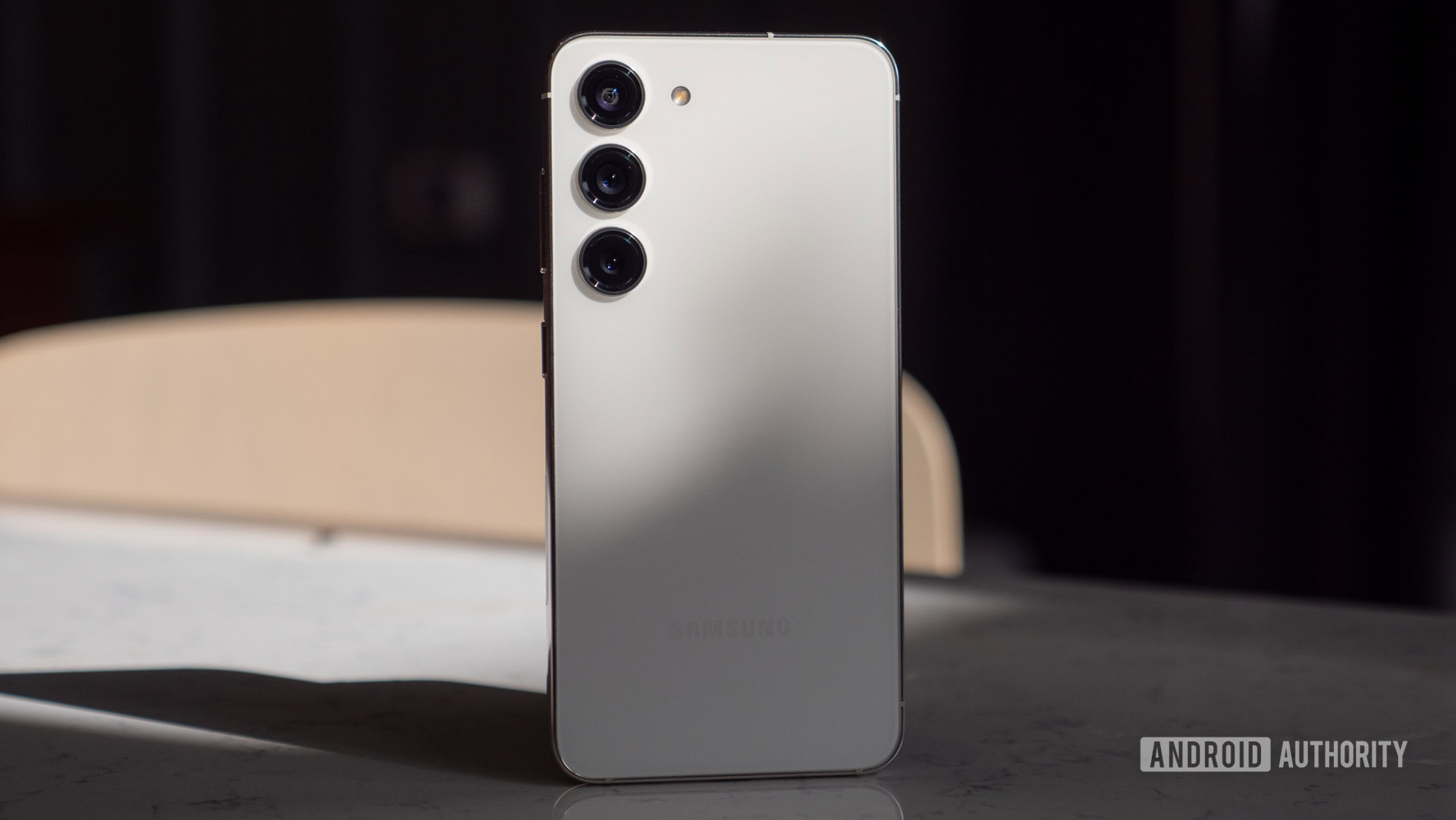


Samsung Galaxy S23
What we like
What we don't like
Our scores

Samsung Galaxy S23
If you’ve seen the Austin Powers sequels, you’re undoubtedly familiar with a little (pun intended) character named Mini Me. He’s a perfect clone of the main antagonist Dr. Evil but shrunk down in size without losing any strength or cunning — you can probably guess where this is going. Yes, the Galaxy S23 is Samsung’s very own Mini Me. It’s the smallest of its lineup, but it offers the same quality level (if not exactly the same specs) across its cameras, software experience, and build as the lead characters; in this case the Galaxy S23 Plus and Galaxy S23 Ultra. The only question is whether the series’ pocket-sized sidekick is the real star. Find out in our Samsung Galaxy S23 review.
Update, January 2024: We’ve updated this review with new alternatives to the Samsung Galaxy S23 and updated software information.
What you need to know about the Samsung Galaxy S23
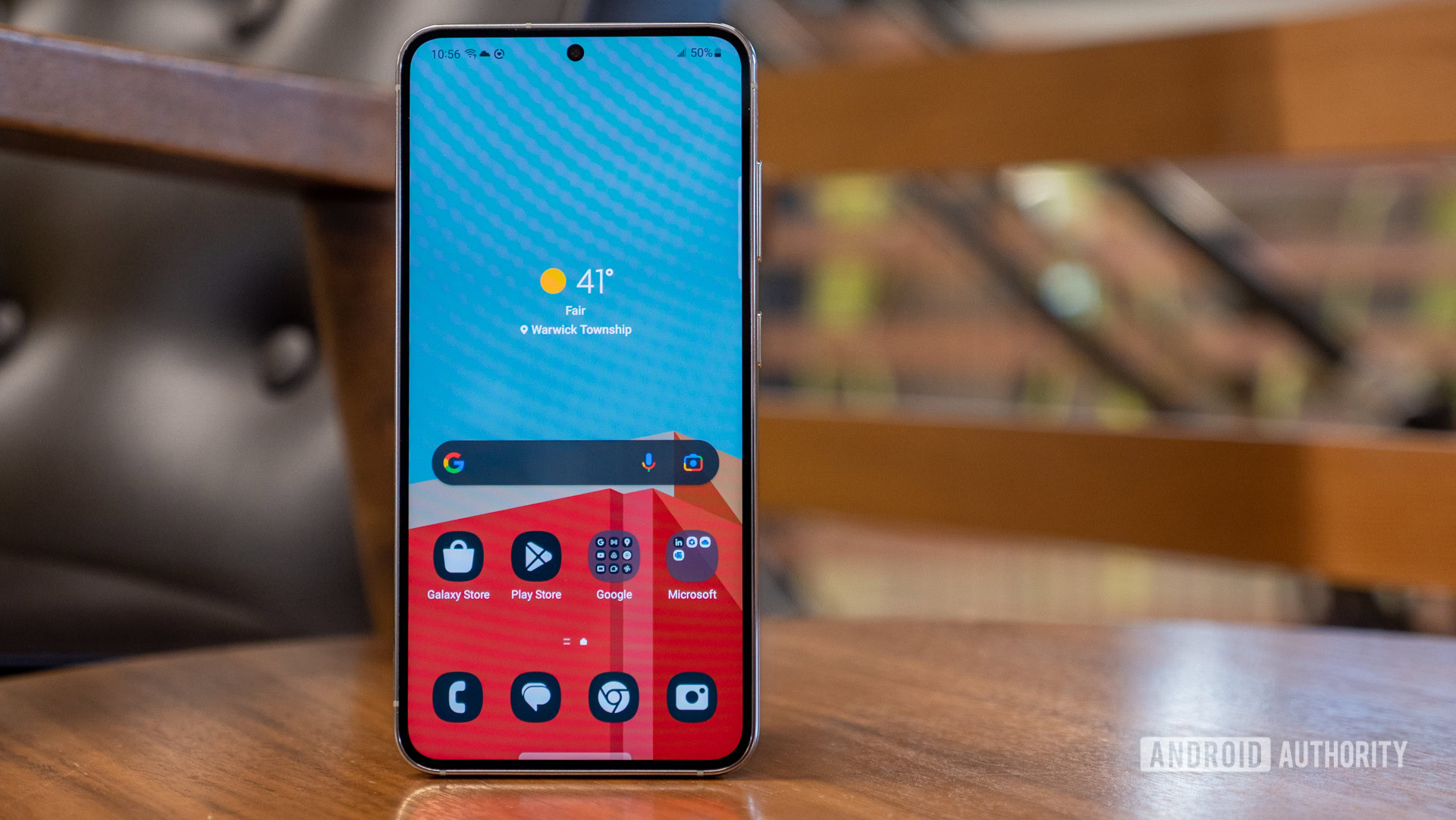
- Samsung Galaxy S23 (8GB/128GB): $799 / £849 / €949
- Samsung Galaxy S23 (8GB/256GB): $859 / £899 / €1,009
Samsung’s Galaxy S23 series landed as the star of the company’s Galaxy Unpacked event in February 2023, with three models taking up now-familiar positions. As usual, the vanilla Galaxy S23 lands at the bottom of the pecking order in size and price. However, it keeps enough specs in common with its larger, more powerful siblings to make the Galaxy S23 a worthwhile option for anyone looking for a smaller phone with big ambitions.
For the most part, the Galaxy S23’s design is the same as that of its predecessor. It still carries a flat 6.1-inch Dynamic AMOLED panel, though it’s been upgraded to Gorilla Glass Victus 2 for extra durability. Like the S23 Plus, its 120Hz variable refresh rate only drops as low as 48Hz when needed, but the display matches the Galaxy S23 Ultra’s peak brightness of 1,750 nits. You’ll also notice the one major change from the Galaxy S22 to Galaxy S23 when you flip the phone over — the Contour Cut camera bump is no more. Instead, each lens sits in its own little ring, lined up in the same order as on the Galaxy S22.
Behind Samsung’s pocket-sized shell, the Galaxy S23 has plenty of punch. It has a slightly larger battery than the Galaxy S22, growing to 3,900mAh, but offers the same 25W wired and 15W wireless charging options. Both available configurations of the Galaxy S23 pack 8GB of RAM, and you can choose either 128 or 256GB of storage.
Samsung continues to refine rather than reinvent, with many of the Galaxy S23's changes under the hood.
Perhaps the most important change in store for the Samsung Galaxy S23 is its new chipset. It runs on Qualcomm’s flagship Snapdragon 8 Gen 2 — specifically Snapdragon 8 Gen 2 for Galaxy, which we’ll dig into later — to keep you at full speed through your day. The “for Galaxy” tweaks are minor, but the Snapdragon 8 Gen 2 was built on TSMC’s 4nm process, the same as the Snapdragon 8 Plus Gen 1, which is a big win for thermal performance.
Elsewhere, the Samsung Galaxy S23’s camera module changes are purely aesthetic. You’re still looking at a 50MP primary sensor flanked by 12MP ultrawide and 10MP 3x telephoto options. The trio offers similar features to those of its predecessor, meaning that you can still tap into Nightography, Expert RAW, and other Samsung camera extras, but there are no major leaps in store. There is a new face on the front, however. Samsung swapped the previous 10MP punch hole selfie camera for a new 12MP option.
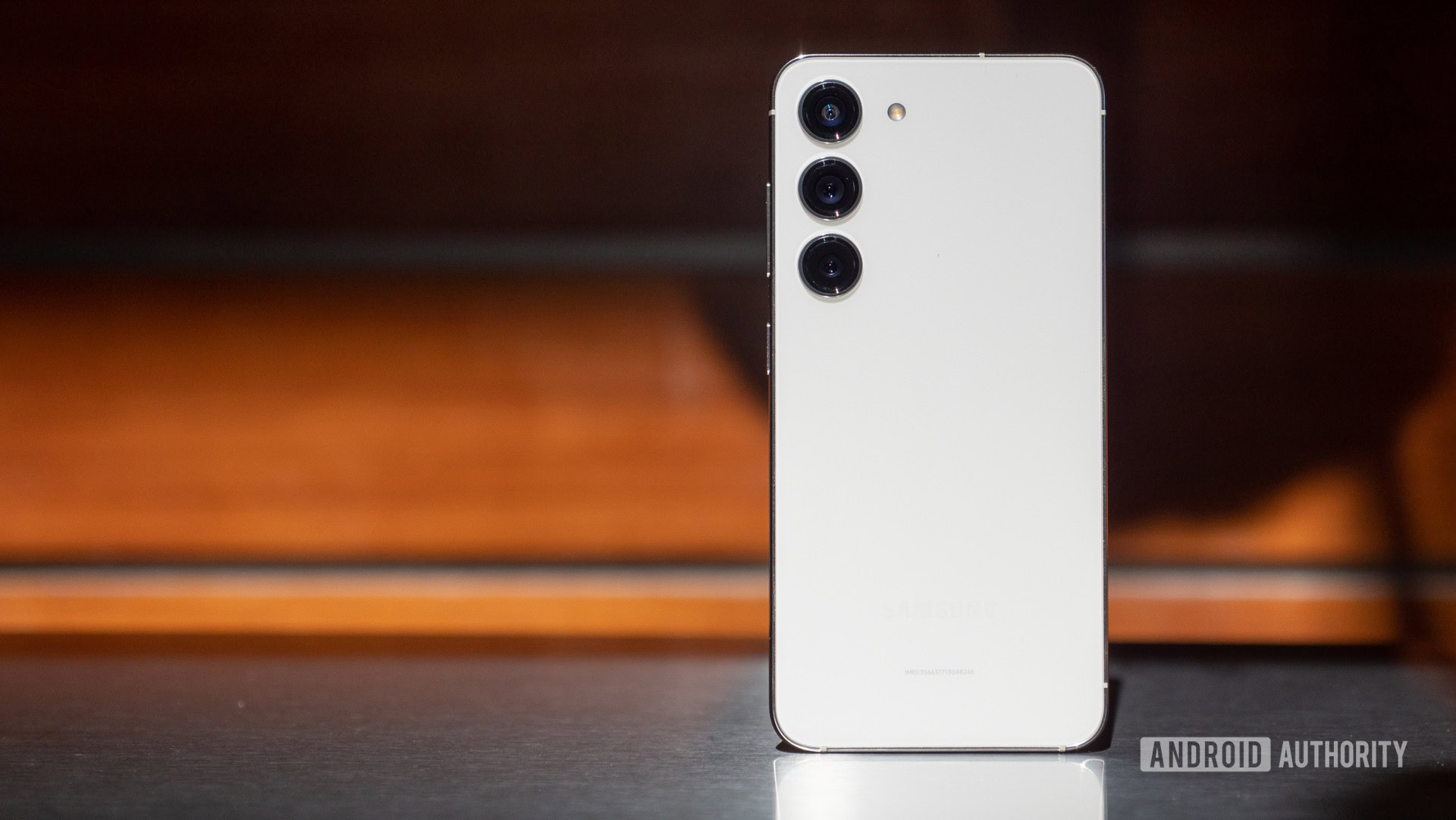
Samsung’s already-slim box contents are as trim as ever with the Galaxy S23, offering no more than the basics. Its tiny black box carries a SIM ejector tool, black USB-C to USB-C cable, essential paperwork, and that’s it.
As for competition, the Galaxy S23 steps into a crowded market that’s finally shifting back towards smaller, more pocketable devices. It’s closely rivaled by Google’s Pixel 8 with its clean software and exclusive features, excellent image processing, and a truly unbeatable price. The OnePlus 11 is another close Android competitor, going head-to-head with the Snapdragon 8 Gen 2 processor under the hood and undercutting Samsung on costs — though it skips wireless charging, among other features. There’s also the iOS side of the aisle, with Apple’s iPhone 15 picking up almost exactly where the iPhone 14 Pro left off, processor, Dynamic Island, and all. Then there’s the freshly launched Galaxy S24, which offers a few worthwhile improvements.
Samsung kicked off pre-orders for the Galaxy S23 series the minute its Unpacked event ended on February 1, 2023, followed by a final release date of February 17. You can grab the trio from Samsung directly, all major US carriers — and many of their MVNOs — as well as several third-party retailers. It comes in four widely available colors: Phantom Black, Cream, Green, and Lavender, and two Samsung Store-exclusive options: Graphite and Lime.
Samsung Galaxy S23 design: Has it changed at all?
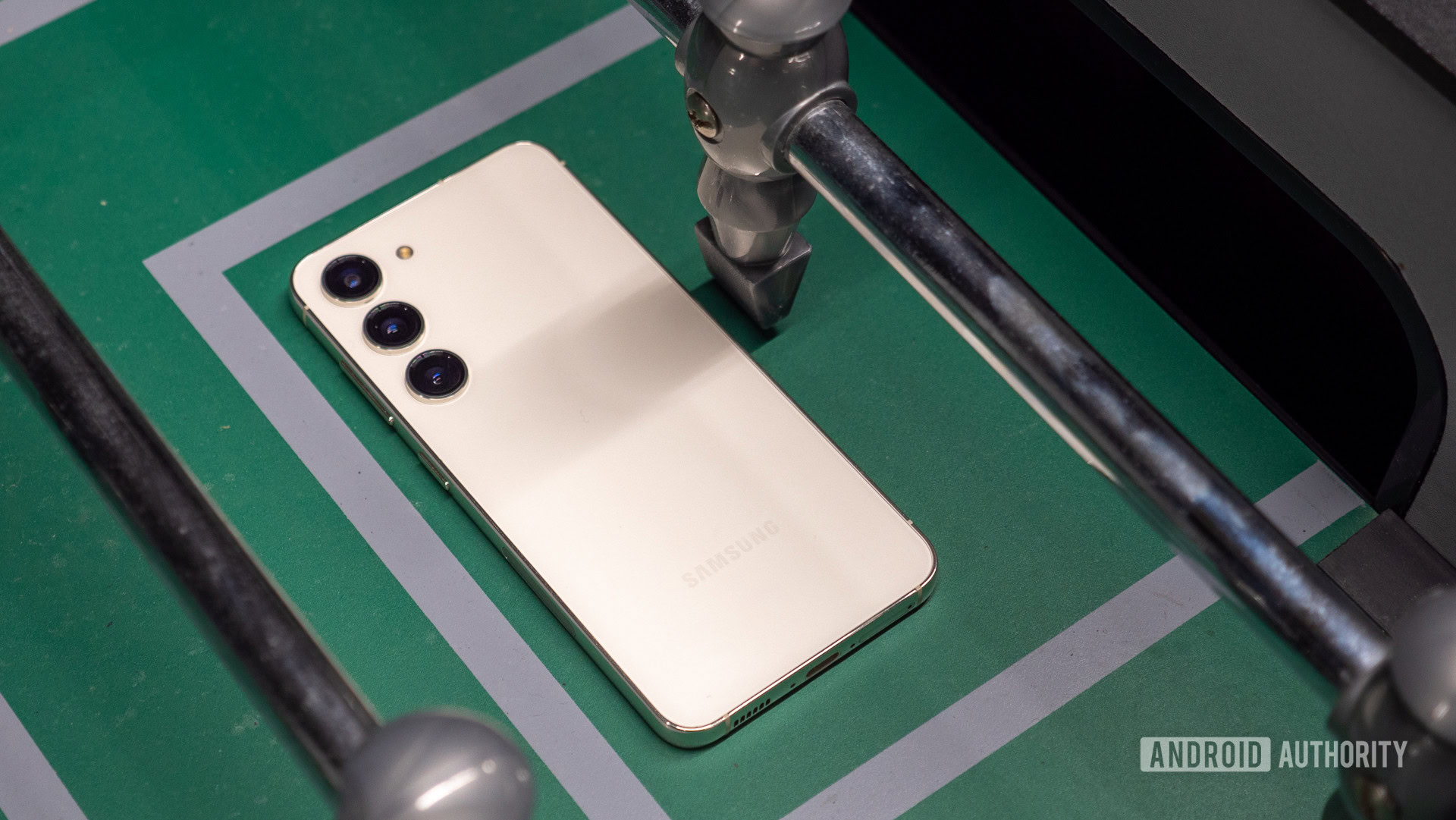
The revamped camera design is the first thing you see when you open the Galaxy S23’s slim black box. All three camera lenses poke through a protective black sheet, resembling three eyes waiting to come to life. Once you peel off the protective layer, you see the rest of the sleek Gorilla Glass Victus 2 panel. It’s rimmed with a shiny frame of Armor Aluminum, matched perfectly to your chosen color. If not for the slimmed-down camera design, you would struggle to tell the Galaxy S23 apart from its predecessor. The satin glass is soft and doesn’t pick up many fingerprints, while the four basic color options are similar — though not identical — to the Galaxy S22’s options.
Jumping back to the Armor Aluminum frame, the Galaxy S23’s relatively flat sides are a joy to hold. They’re similar to those of the Galaxy S22 series, meaning that they still have a slight curve and are far more comfortable in hand than Apple’s flat iPhone rails. The frame is punctuated by a familiar button layout, tucking the power button below the volume rocker on the right side, while the USB-C port and SIM tray hold down the bottom edge. There’s no S Pen slot — nor does the diminutive Galaxy S23 support the stylus even if you buy one separately — so the overall look and feel is clean and simple.
The Galaxy S23's mix of clean design and premium materials are better than they've ever been — even if they're not revolutionary.
Ultimately, the design and build quality of Samsung’s Galaxy S23 series is as high as it’s ever been. The “glasstic” material of the Galaxy S21 is a thing of the past, yet the beloved Phantom finishes have stuck around. I don’t even worry about the phone slipping or sliding when sat on a flat surface, thanks to the almost nonexistent camera array. You might miss a little of the personality if you’re not one for minimalism, but you’ll never complain about the Galaxy S23 being uncomfortable to hold. There’s also an IP68 rating for water and dust resistance, which nicely complements the tougher Gorilla Glass Victus 2 for impressive durability. Though, as ever, we’d still recommend you buy a decent Galaxy S23 case to keep it fully protected.
Samsung Galaxy S23 battery life and charging
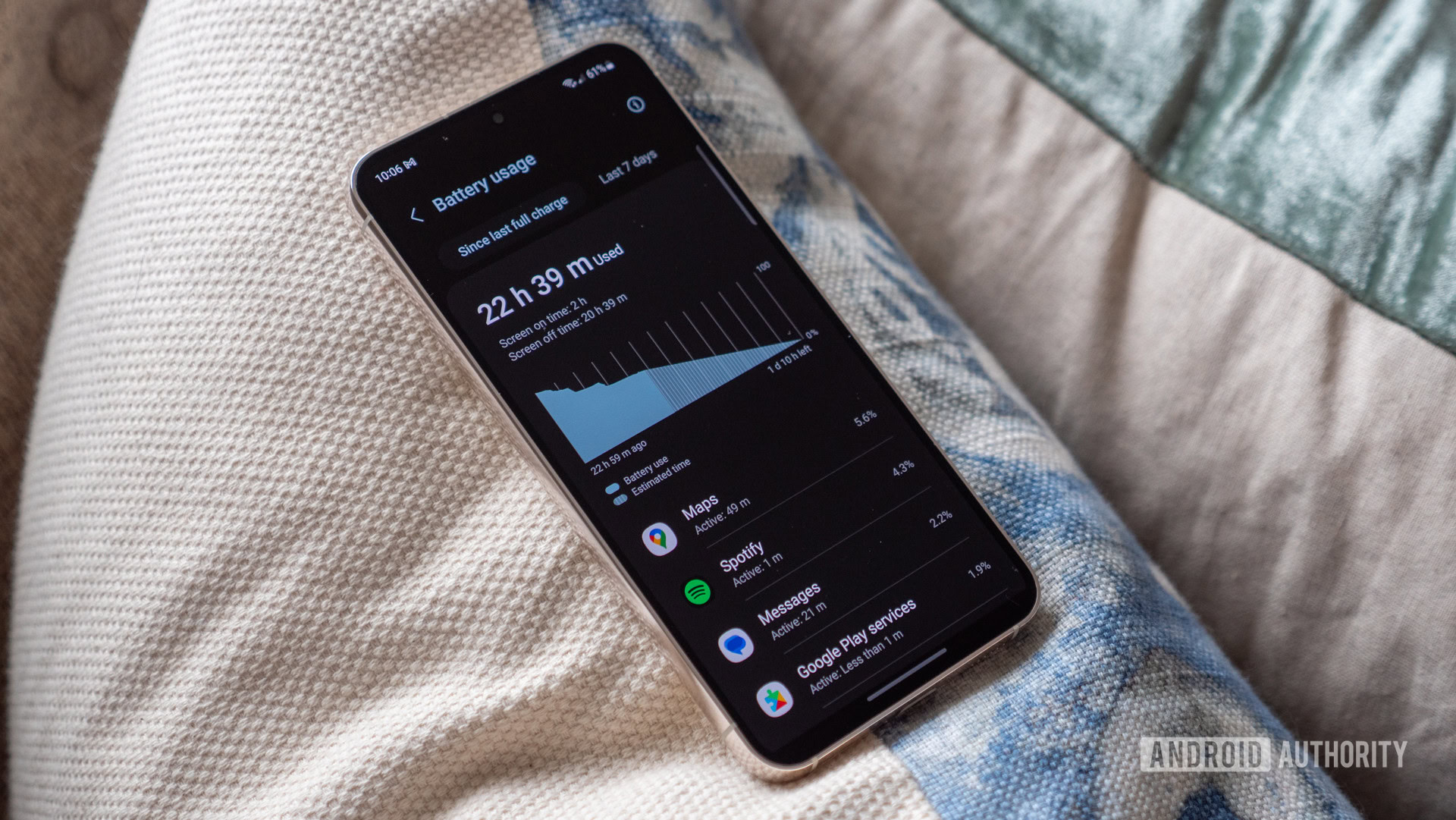
The Samsung Galaxy S22 wasn’t a great phone for overall battery life or charging, partly as a victim of its small cell, but also the thermal-hogging chipset that was the Snapdragon 8 Gen 1. As such, I was more than a little nervous to see what the more efficient (on paper) Snapdragon 8 Gen 2 for Galaxy could squeeze out of a slightly larger battery. Thankfully, my fears were unfounded. Our unit is still learning my usage patterns thanks to a jam-packed February full of phone-hopping, but during early testing, the Galaxy S23 stood up to a busy day much better than its predecessor.
My usage was, as ever, very mixed, with hours of Spotify streaming and video streaming, as well as a good mix of Google Maps navigation and social media scrolling in my downtime. The Galaxy S23 took most of it in stride, only warming during longer stretches of simultaneous navigation and Spotify streaming — two uses that often go hand in hand in my case. I didn’t put the Galaxy S23 through extended gaming stress, but I would have no qualms about short sessions. You’ll just have to remember that heat and small cells aren’t conducive to long battery life, so you may want to fit some breaks into your Asphalt 9 racing.
The Galaxy S23 handles battery life much better than its predecessor, but charging power still lags behind.
In the end, I’m getting around a day and a half of use out of the Galaxy S23 before I need to charge. I’ve been finishing a day with around 40% battery remaining and only losing a handful of charge overnight. When the battery does run out, you’re faced with a familiar — and slightly underwhelming — set of charging standards to work with. The Galaxy S23 still offers just 25W wired charging, while its Galaxy S23 Plus and Galaxy S23 Ultra siblings bump to 45W speeds. In my experience, it takes just about 80 minutes to fill the 3,900mAh cell using a USB Power Delivery PD brick. In fairness, that’s around 20 minutes faster than an iPhone 14 and Pixel 7, but it’s still a disappointment when you consider that a compatible plug can top up the Galaxy S23 Ultra’s beefy 5,000mAh cell in under an hour.
You can also completely refill the Galaxy S23 in about 100 minutes with the 15W wireless charging via Samsung’s official pads, though it’s also compatible with 10W Qi charging as a backup. There’s also support for Wireless PowerShare if you want to trade some juice with an accessory like a pair of Galaxy Buds or a Galaxy Watch.
As usual, Samsung doesn’t include a charger with the Galaxy S23, meaning you’ll have to supply your own. Make sure that it supports USB Power Delivery PPS, too, as others can cap out at just 15W. Luckily, we’ve been down this road a few times, so we have some Galaxy S23 charger recommendations ready to go.
Also, one final gripe with the battery brings Samsung’s software into the picture. Although the phone will prompt you to turn Power Saving mode on, it doesn’t toggle itself back off when you finish charging your battery. Unless you go back in and turn it off, you can go through entire days with limited background network and location use and a refresh rate limited to 60Hz — trust me, I’ve done it.
Samsung Galaxy S23 performance: Testing the Snapdragon 8 Gen 2 for Galaxy

The vanilla Galaxy S23 doesn’t have its eyes on Galaxy-loving power users — that title belongs to the Galaxy S23 Ultra. However, there are still performance marks to be upheld, especially when you’re asking $799 for a smartphone. Like its battery triumph, the Galaxy S23 met and exceeded most of my performance hopes on paper and in real life. It walks a comfortable line between power and efficiency. After all, a cool phone is a phone that can last, and the Galaxy S23 is (generally) a cool customer.
Qualcomm’s Snapdragon 8 Gen 2 chipset gives the Galaxy S23 a little extra punch to work with than the Galaxy S22. Where the previous phone’s Snapdragon 8 Gen 1 chipset relied on a trio of identical performance cores, the Snapdragon 8 Gen 2 bumped to four performance cores and split its load across the Cortex A710 and A715. This means it can handle multi-core performance better and continues to support older 32-bit apps, even as most apps update to 64-bit. We have a deep dive that goes much further into the weeds of Qualcomm’s Snapdragon 8 Gen 2 chipset, so head on over there if you want to get up to your eyes in cores and gigahertz.
On top of the standard Snapdragon 8 Gen 2 design, Samsung’s implementation kicks things to 11. Its “Snapdragon 8 Gen 2 for Galaxy” branding means the CPU and GPU clock speeds are higher than the standard chipset’s. The Snapdragon 8 Gen 2 for Galaxy hits 3.36GHz on the CPU instead of 3.2GHz, followed by 719MHz instead of 680MHz on the GPU. This is similar to how Qualcomm usually approaches its mid-cycle “Plus” chipsets, so we’ll have to wait and see if similar speeds trickle to other devices later in the year and how Samsung handles its own mid-cycle launches like the expected Galaxy Z Flip 5 and Galaxy Z Fold 5.
For now, the Galaxy S23’s benchmarking performance backs up the idea that Samsung’s special chipset is a bit different from its predecessor, as well as other Snapdragon 8 Gen 2 phones. It posted a 35% increase in single-core Geekbench 6 performance over the Galaxy S22 and a ~52% bump in multi-core performance. Both numbers are impressive and show how much difference an extra performance core can make. Our 3D Mark Wild Life test run returned similar improvements, maxing the base test and topping out at 12,820 on the stress test. It sagged off in the later runs but settled at just under 8,000. That’s much higher than the Galaxy S22’s final loops, and nowhere near the sub-6,000 numbers we saw for the Gen 2-powered OnePlus 11 at its lowest points, though the smallest Galaxy S23 was a fraction behind in terms of peak GPU performance.
Regardless of the controlled benchmark scores, it’s all about how the Samsung Galaxy S23 handles the day-to-day. During my testing, it handled everything I asked without issue. I didn’t notice any problems with apps starting slowly, and the thermal performance was mostly under control, other than when first running through the setup process. The Snapdragon 8 Gen 2 for Galaxy breezes through streaming and other typical tasks, even when combined with navigation, and still has time for a few quick emails on the side. Sprinting through long Spotify playlists or the YouTube homepage has a bit of a load time, but only if you’re trying to cover a lot of ground quickly and all at once.
It's not the Galaxy phone for power user, but the vanilla S23 still packs a punch.
The Samsung Galaxy S23 is also content to roll with a familiar set of configurations: 8GB of RAM and either 128GB or 256GB of storage. This is in line with several phones at this price point (Google Pixel 8, OnePlus 11, ASUS Zenfone 10), though it comes up a bit short of the 12GB of RAM you’ll find on more expensive flagships. So far, 8GB has been plenty for my use, but it could come up short if you want to run multiple heavy-duty apps at once. Something as simple as Chrome can hog 2GB at a time, putting a clamp on how much you can do simultaneously. Of course, there’s no 12GB version of the Galaxy S23, so we can’t really speculate how that version would handle life.
Also, the vanilla Samsung Galaxy S23 is the only one in its family that starts with 128GB of storage, which seems odd. Both the Galaxy S23 Plus and Galaxy S23 Ultra base models come with 256GB, with the latter reaching up to 1TB of storage — significantly more room when there’s no SD card slot to play with. The good news is that there appears to be a 512GB storage Galaxy S23 model on the way for those who want to store a ton of large files on their diminutive phone. The bad news is that, at the time of this writing, the maximum storage Galaxy S23 model you can actually buy is the 256GB variant.
Galaxy S23 cameras: Is this the best small camera phone?
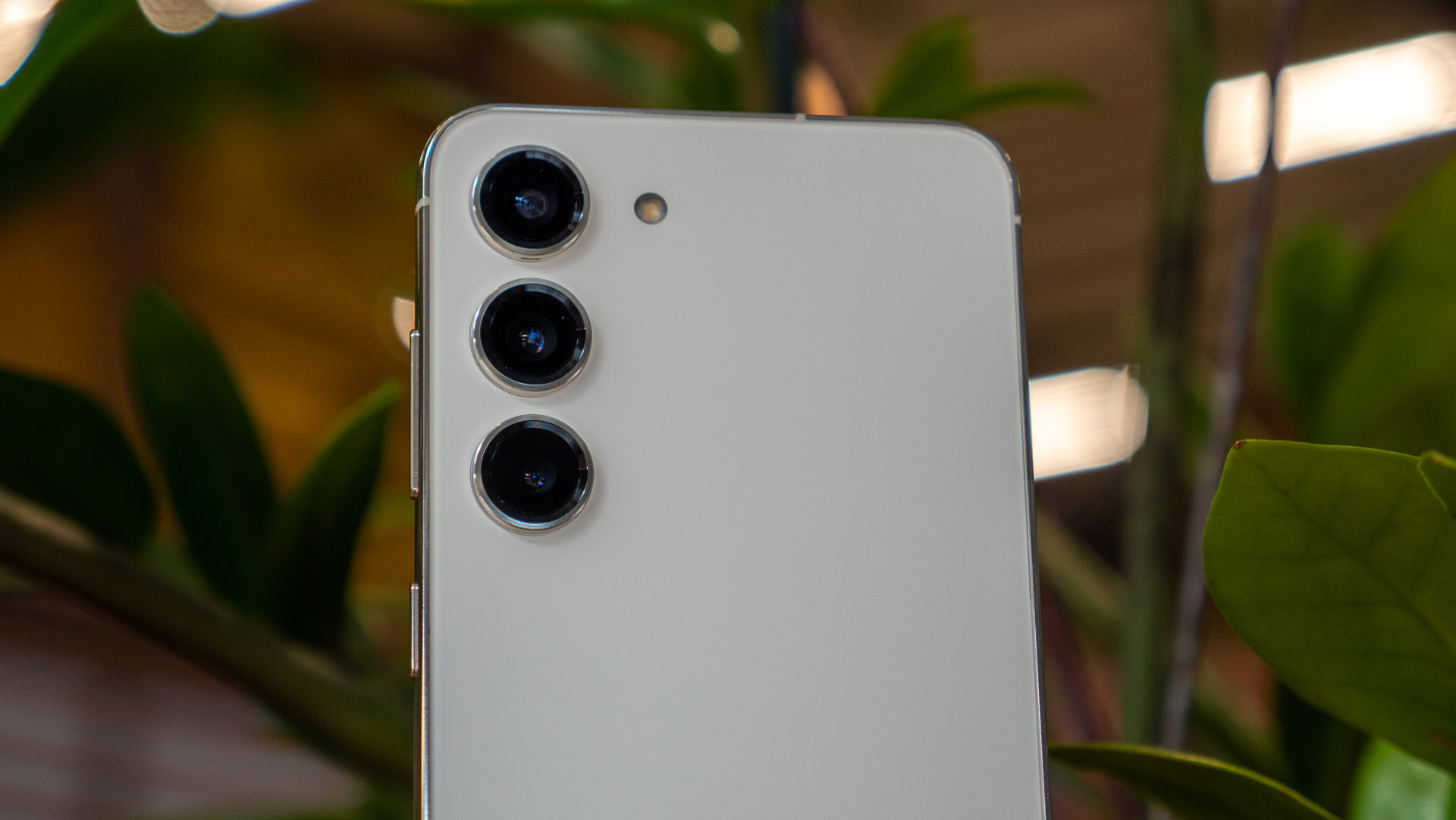
We’re all creatures of habit, smartphone makers included. Samsung has established its reputation as a kingmaker in the pantheon of the best camera phones and while the Galaxy S23 Ultra received a headline change with its 200MP main shooter, the other two members of the Galaxy S23 family have shown no intention of rocking the boat. Not that they have to.
The slimmed-down camera housing is the most noticeable hardware change for the year. Otherwise, you’re still looking at the same 50MP primary, 12MP ultrawide, and 10MP telephoto trio from the Galaxy S22. The primary shooter pixel-bins by a factor of four to give you 12.5MP images by default, but you can opt for full-resolution 50MP snaps too. The Galaxy S23’s other two lenses match the indomitable Galaxy S23 Ultra, so there’s no shortage of quality. You can punch out to 0.6x with the ultrawide lens at a 120-degree field of view, or take advantage of 3x optical zoom via the telephoto lens.
The Galaxy S23 camera setup settles for familiar reliability.
Samsung isn’t alone in its updated camera powers, as Qualcomm’s Snapdragon 8 Gen 2 chipset has its own role to play. One of its most significant updates is a new Cognitive ISP, which uses AI to process real-time semantic segmentation. For the uninitiated, that means recognizing elements of your image as you see it and fine-tuning the details before you press the shutter button. The Cognitive ISP covers most everyday elements: eyes, teeth, cats, dogs, and your Instagram-worthy food pics.
You’ll taste most of these features through Samsung’s comprehensive camera app. The default setup gives you all the controls you could ask for, including the freedom to play with ISO, aperture, and white balance — though Samsung’s automatic settings are usually pretty spot on. I know my way around a camera pretty well, yet I find myself letting Samsung do most of the work. Still, it’s nice to know that you have more power at your fingertips than Google’s fire-and-forget approach if you want it. If that’s still not enough control for you, you might find Expert RAW right up your alley. It mixes the pro-level controls mentioned above with the ability to export images in the RAW format for editing in programs like Lightroom. It also now has a dedicated shortcut in the Advanced menu of Samsung’s camera app for quicker access.
One of Samsung’s major software updates also improved its camera performance, unlocking features like the ability to snap the shutter button before the Galaxy S23 is fully focused. You might not think such a feature would be useful, but sometimes you need just a little more snapping speed.

Samsung’s commitment to a familiar camera setup meant I had a pretty good idea of what I was getting into with the Galaxy S23. That didn’t make it any less impressive; just a bit easier to know what to expect. I took advantage of one of the few sunny days in Pennsylvania in Spring and tried to capture as many colors and scenes as possible.
Historically, Samsung has tended to boost reds and greens in its color science, and that trend remains alive and well. The image of two metal suns is vibrant, while the red flag behind them is brighter than in real life. Other reds, like that of the brick Dispensing Co. building and the mural of the Puerto Rican flag, are punchier than reality, especially as both were taken on cloudy days. Outside of colors, I had no complaints about the level of detail in Samsung’s binned 12.5MP images; all of the leaves are crisp in the bottom right image, as are the carving lines in the ice sculpture.
The Galaxy S23’s ultrawide camera maintains a similarly high level of detail, with several of the banners in the arena to the left still legible. Tiny details towards the back of the market scene get a bit soft, especially if you zoom in on individual stands further from where I was standing. On the bright side, the only image that shows any distortion is that of the Dispensing Co. building, where some of the pedestrians seem a bit skewed, along with the minivan to the right edge of the image. Samsung’s ultrawide color palette is a shade lighter than the primary camera, which is the opposite of what we saw with the Galaxy S23 Ultra.
The zoom capabilities on the standard Galaxy S23 might not be up to that of the Galaxy S23 Ultra, but they’re still pretty remarkable. Shots from the 10MP telephoto lens are extremely crisp at 3x zoom — its default length — making it easy to pick out individual menu items and costs on the chalkboard to the left-hand side. Details get admittedly softer once you hit 10x zoom, such as the man’s face and the person’s arm at the cash register to the right. The Galaxy S23’s 30x zoom tells a similar image, giving up on any details of the sheep’s head yet somehow showing more detail in the grass than the 10x zoom image. Color recreation is pretty similar even at digital zoom, at least.
Where the Galaxy S23 Ultra also showed excellent edge detection in portrait mode thanks to its AI-powered semantic segmentation, the base Galaxy S23 seems to take a step back. It nailed all of the edges on the human-shaped statue to the left but struggled a bit in both other images. Some of the rabbits are out of focus in the middle picture, while much of the foreground around the fairy is still in clear focus. You can see parts of the background where the Galaxy S23 blurred correctly, but it doesn’t make the small statue pop as the subject.
The level of light that Samsung’s night mode manages to recover is nothing less than remarkable. The below image on the right is closer to what my eye could see, while the image to the left took just three seconds to capture and process. It gets a little soft on the details, such as the tree branches or the wooden shingles, but no part of the image is too blurry or smudged to make out. Images further down — both with and without night mode active — show even better levels of detail. The front of the chocolate store is crisp with accurate colors while still showing the surrounding darkness nicely. I got a bit of lens flare in the image second from the left, but that was coming from a light source directly to the left of the camera rather than a dirty lens.
Finally, the selfie camera. While Samsung didn’t change its rear camera array, it gave the selfie shooter a pretty solid facelift. It’s a 12MP sensor that matches the Galaxy S23 Ultra, rather than the previous 10MP option. There’s no huge difference in quality — results are still sharp, colors are still good — and edge detection remains largely spot-on. It missed a few of my wisps of hair, but many other cameras would have done the same on the right side of my head. The Galaxy S23 accurately picked out the pom-pom on top of my hat, which is another usual suspect when it comes to artificial bokeh.
Although the Samsung Galaxy S23 doesn’t keep up with the massive megapixels of its high-powered sibling, it offers the same video features. It’s ready for up to 8K video at 30fps, or you can drop to a more reasonable 4K resolution at 60fps for high-res video capture. The selfie camera offers a similar mark, hitting 4K at 60fps. I was pleased with the results, especially the stabilization while walking around the ice festival in my hometown. Just keep in mind that you might fill the Galaxy S23’s storage quickly with higher-resolution videos, so you may want to price out the 256GB upgrade, or even wait for more details on the supposed 512GB model.
If you want to check out full-size versions of the camera samples above (and many more), you can do so at this Google Drive link.
Anything else?
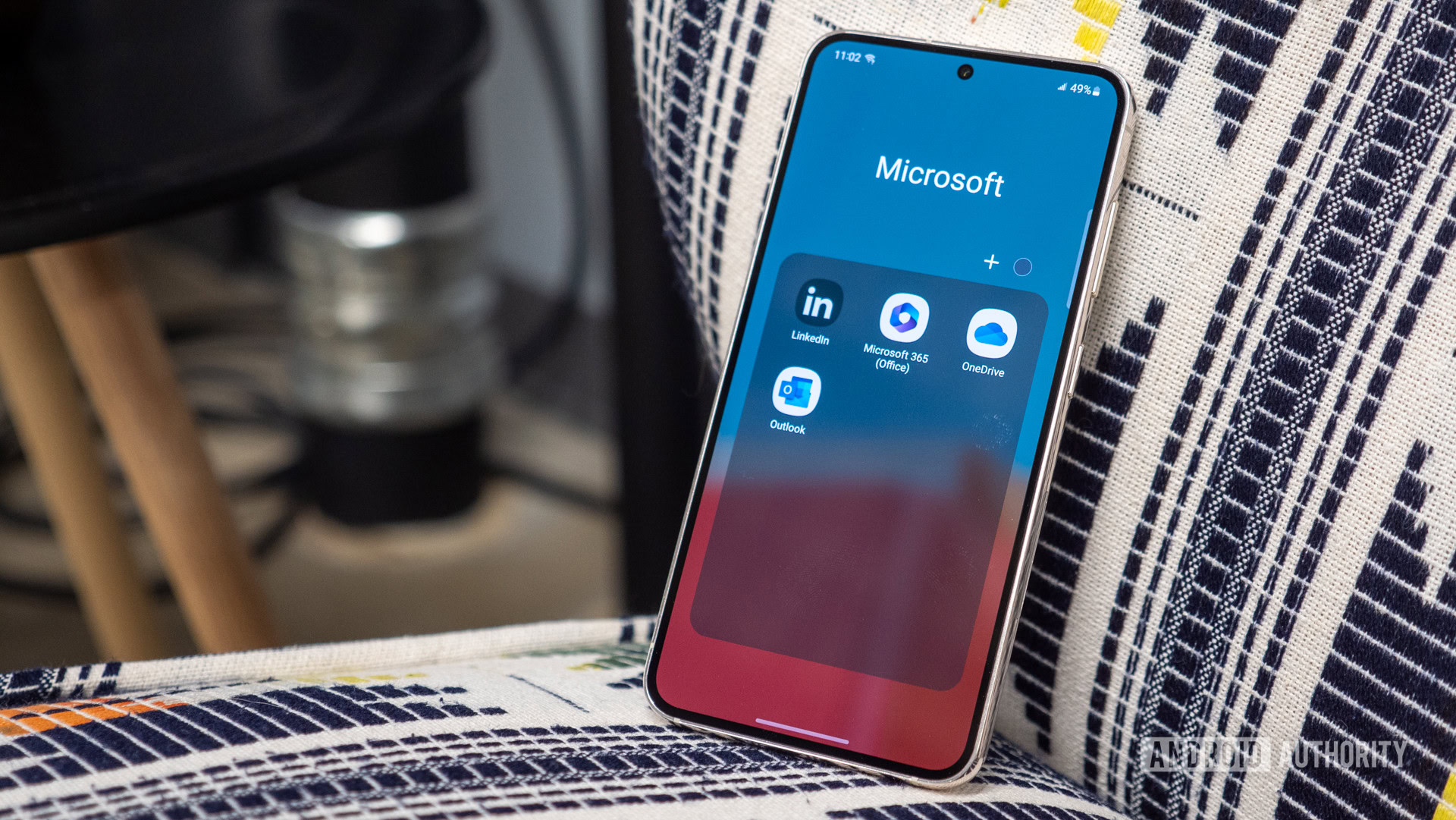
- Software: Samsung’s Galaxy S23 arrived with Android 13 onboard and the shiny new One UI 5.1 skin right out of the box. It’s not much different than One UI 5.0 at first glance, but there are plenty of tweaks if you know where to look. For starters, Samsung’s color-matched app icons go much further than before. The Material You-inspired theming used to be restricted to first-party Samsung apps but now includes everything from Slack to Spotify. You can also set different wallpapers for your activities (work, sport, whatever), and there are new weather and battery widgets to make planning your day a little easier.
- Ecosystem: Samsung truly has a galaxy at its disposal. It’s coming for Apple’s ecosystem crown in a big way, thanks to an ever-growing stable of wearables, smartphones, earbuds, and Windows laptops. Oh, and tablets. And Chromebooks. Even better, all of Samsung’s products link together through a series of playback and file-sharing apps, and getting set up is easier than ever.
- Display: The Galaxy S23’s 6.1-inch AMOLED panel is bright and offers great colors while still offering a FHD+ resolution like that of its predecessor. It’s not really a surprise to see a 1080p panel on a non-Ultra Samsung phone at this point, and while there’s reason to expect a little better at this price, it’s not like you’d see the full impact of QHD+ in such a small display. The Galaxy S23 also misses out on the truly adaptive refresh rate of the Galaxy S23 Ultra, only dropping as low as 48Hz, but this didn’t appear to have a significant hit on battery life.
- Biometrics: Apple might still have the facial recognition edge with Face ID, but Samsung’s love for the ultrasonic in-display fingerprint reader is unrivaled. It’s back in its familiar position on the Galaxy S23, and its small design makes it easy to reach with one hand. That said, the setup process feels quicker and easier as part of One UI 5.1, requiring fewer scans to build a full picture of your fingerprint. Otherwise, the Galaxy S23 supports facial recognition, but due to the lack of dedicated hardware, it’s not quite as secure as Apple’s solution.
- 5G: The Samsung Galaxy S23 series supports both mmWave and sub-6GHz 5G in the US, and I stayed connected without issue. I used my personal Verizon SIM during my testing, with reliable access to 5G speeds throughout, even when my hometown was far more crowded than usual — often when high speeds struggle.
- Audio: While the Galaxy S23 might not quite match the booming Galaxy S23 Ultra, it’s still a solid audio performer. It achieved great volume and clarity from the single down-firing unit and the earpiece, and there was no distortion. Like most phones, higher pitches, like the human voice and guitars, come through best, but lower tones are still noticeable. Samsung’s robust Bluetooth connectivity and codec support (as well as Bluetooth LE) stand in for the long-since-retired headphone jack.
- Connectivity: There’s no shortage of connectivity options in the Samsung Galaxy S23’s supporting cast. It brings Wi-Fi 6E (not Wi-Fi 7, but still plenty future-proofed), Bluetooth 5.3, and an NFC chip for wireless payments. It does miss out on UWB support though, so you won’t be able to pair it up with Galaxy SmartTags and the like.
- Updates: Samsung’s update policy remains among the best in the Android business, save for the Pixel 8, of course. It’s tough to scratch four years of Android version updates and five years of security patches. Given that the Galaxy S23 already offers Android 13 out of the box, that should carry you through to Android 17 and 2028 before you’re out of software support. Samsung has since dished out Android 14-based One UI 6 to the handset and its siblings.
Samsung Galaxy S23 specs
| Galaxy S23 | |
|---|---|
Display | 6.1-inch Dynamic AMOLED Flat display 19.5:9 aspect ratio FHD+ resolution (2,340 x 1,080) 120Hz adaptive refresh rate |
Processor | Snapdragon 8 Gen 2 |
RAM | 8GB |
Storage | 128GB or 256GB No microSD card support |
Power | 3,900mAh battery 25W wired charging 15W wireless charging No charger in box |
Cameras | REAR: - 50MP wide - 12MP ultrawide - 10MP telephoto FRONT: - 12MP wide |
Software | Android 13 One UI 5.1 |
S Pen support | No |
IP rating | IP68 certified |
Weight & Dimensions | 146.3 x 70.8 x 7.6mm 168g |
Colors | Phantom Black Cream Lavender Green Samsung Exclusives: Graphite Lime |
Other specs | IP68 WiFi 6E Gorilla Glass Victus 2 Vision Booster (Adaptive) Selfie Night Portrait |
Value and competition
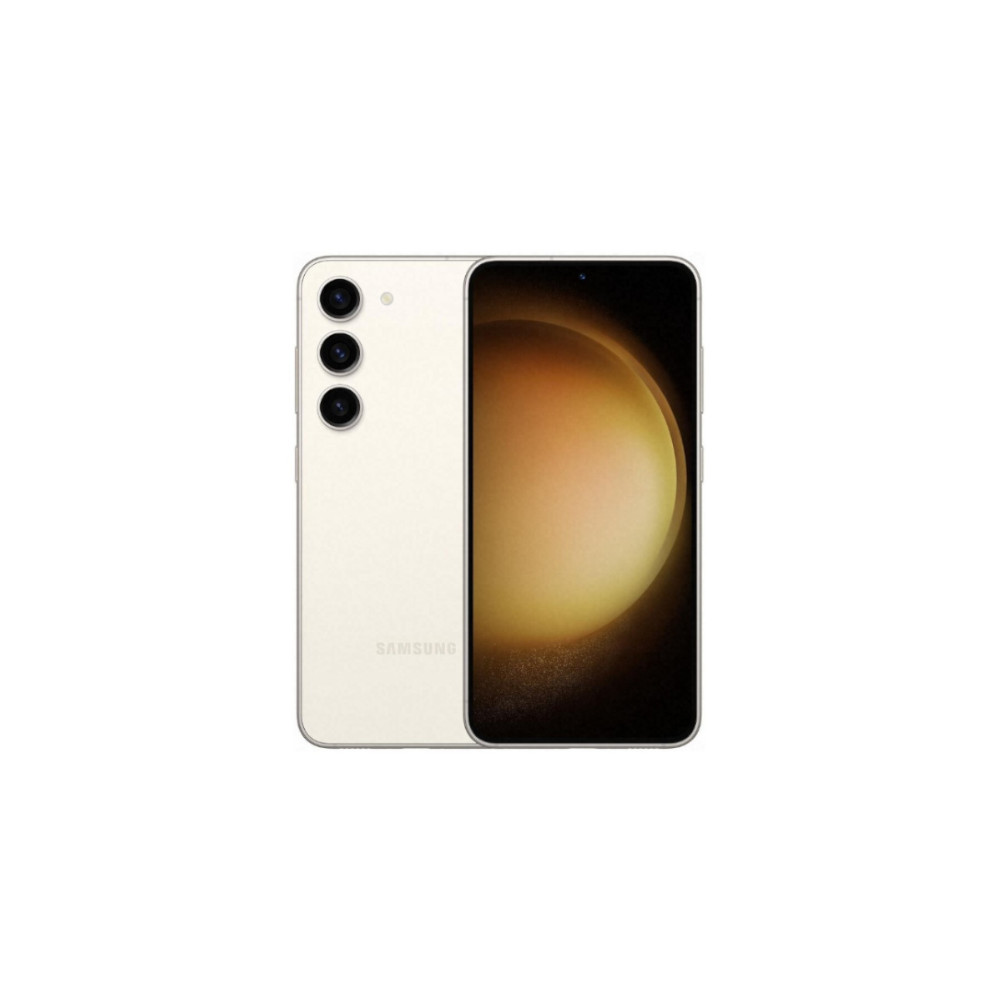

The Samsung Galaxy S23 is a giant among small phones — it knows where it sits and what it offers, and it won’t ask for a penny less. Samsung hasn’t increased the price over the previous generation in the US, meaning you can grab the pint-sized powerhouse for $799 in the base configuration. Sadly, the Galaxy S23 series did pick up a hefty price increase in other markets like Europe, making the Galaxy S23 a little less appealing at prices upwards of €1,000.
The first and most obvious Galaxy S23 alternative is its replacement, the Galaxy S24 ($859.99 at Amazon). While it’s almost identical in several facets, the new phone stores more power, runs a more powerful Snapdragon 8 Gen 3 for Galaxy chipset, features a larger display, and boasts a much longer software support window. If you’re into the idea of more AI on phones to boost productivity and image editing, Samsung’s Galaxy AI toolkit might interest you. More importantly, the Galaxy S24 launches at the same price as its predecessor, making it the better onboarding point for Samsung newcomers.
Google’s Pixel 8 ($699 at Amazon), with its light, smooth, exclusive-feature-packed software, and unbeatable price tag. Like Samsung, Google chose to refine its design rather than reinvent it, bringing some shine to the camera bar and a new Tensor G2 chipset under the hood. The Pixel 8 is also the opposite of the Galaxy S23 in many ways, preferring to let Google and its machine learning smarts do all of the heavy lifting in terms of performance and camera controls, while Samsung lets you get your hands as dirty as you please.
Ultimately, Google and Samsung are locked head-to-head in a battle to be the best small-ish Android phone. Of course, if size isn’t a factor, you could quite easily consider the Pixel 8 Pro ($999 at Amazon) for only $200 more which adds a telephoto camera, fractionally faster charging, and a higher resolution display into the Pixel mix.
If you want a really small Android phone — one below the six-inch mark, no less — your only real option is the ASUS Zenfone 10 ($699.99 at Amazon), which comes in with a 5.92-inch display. Despite its tiny size, ASUS’ 2023 Zenfone still finds space for a 4,300mAh battery (400mAh larger than the Galaxy S23) and even a headphone jack. It now has wireless charging, though it still offers a plastic back panel instead of Samsung’s tough Gorilla Glass Victus 2. The good news is that ASUS did secure an IP68 rating for water and dust resistance. There’s even a version of the Zenfone 10 with as much as 16GB of RAM if you’re looking to push it to its limits, though you’ll have to shell out an extra $100 for it.
Moving to the larger but still reasonably priced end of the Android market, there’s the OnePlus 11 ($1296 at Amazon). It dwarfs the Galaxy S23 with a 6.7-inch display and blazes past Samsung with 80W wired charging (in the US) and a 5,000mAh battery. However, OnePlus’ flagship doesn’t have too many other outright advantages. It stripped away wireless charging, reasoning that its wired speeds are fast enough that consumers won’t miss the feature. Meanwhile, Samsung’s IP68 rating and Gorilla Glass Victus 2 still trump OnePlus’ IP64 and Gorilla Glass Victus approach.
The all-conquering Galaxy S24 Ultra ($1419.99 at Amazon) is perhaps a stretch too far, but it’s easy to recommend either the Galaxy Z Flip 5 ($999.99 at Samsung) or the Galaxy S24 Plus ($1119.99 at Amazon) if you’re willing to splash a little extra cash. Both will push you right up against the $1,000 barrier, but you’ll get a bit more bang for your buck while you’re at it. The Galaxy S23 Plus sees a 6.7-inch display and a 4,900mAh battery — both bumps over the S23 Plus — and 45W wired charging. Notably, bar the AI tricks on the new phones, the Galaxy S23 and S24 series should share a similar camera experience, so it could still be well worth opting for the older lineup.
The Samsung Galaxy S23 is a giant among smaller phones.
If you go for the Galaxy Z Flip 5, you’re opting for a unique form factor over a traditional slab design. It comes at the cost of a telephoto lens, but you’re getting a phone that can fold and takes up even less space in your pocket. The Galaxy Z Flip 5 also offers a tall 6.7-inch display, which has no shortage of real estate. It has the same 3,700mAh battery capacity as the Galaxy S23, so your mileage may suffer as it has to power a larger device, but it’s tough to pass up the form factor. Just keep in mind that the Galaxy Z Flip 5 comes with an IPX8 rating for water resistance, as the hinged design means it won’t play nicely with dust.
Finally, you have the option to venture outside of the realm of Android. Apple’s iPhone 14 Pro 2.0 — er, iPhone 15 ($829.99 at Amazon) — is the most sensible starting point, given its similar price tag and footprint. It’s similar to the Galaxy S23 in other ways, too, with flat sides and long software support, but moving to the iPhone will require you to fully embrace eSIM as a way of life, for better or worse. Samsung also offers three rear cameras to Apple’s trusty twosome, so you’ll get much better zoomed shots out of the Galaxy S23. That said, if you want the best facial recognition in the game, Apple’s Face ID remains as quick and reliable as it is secure.
Samsung Galaxy S23 review: The verdict
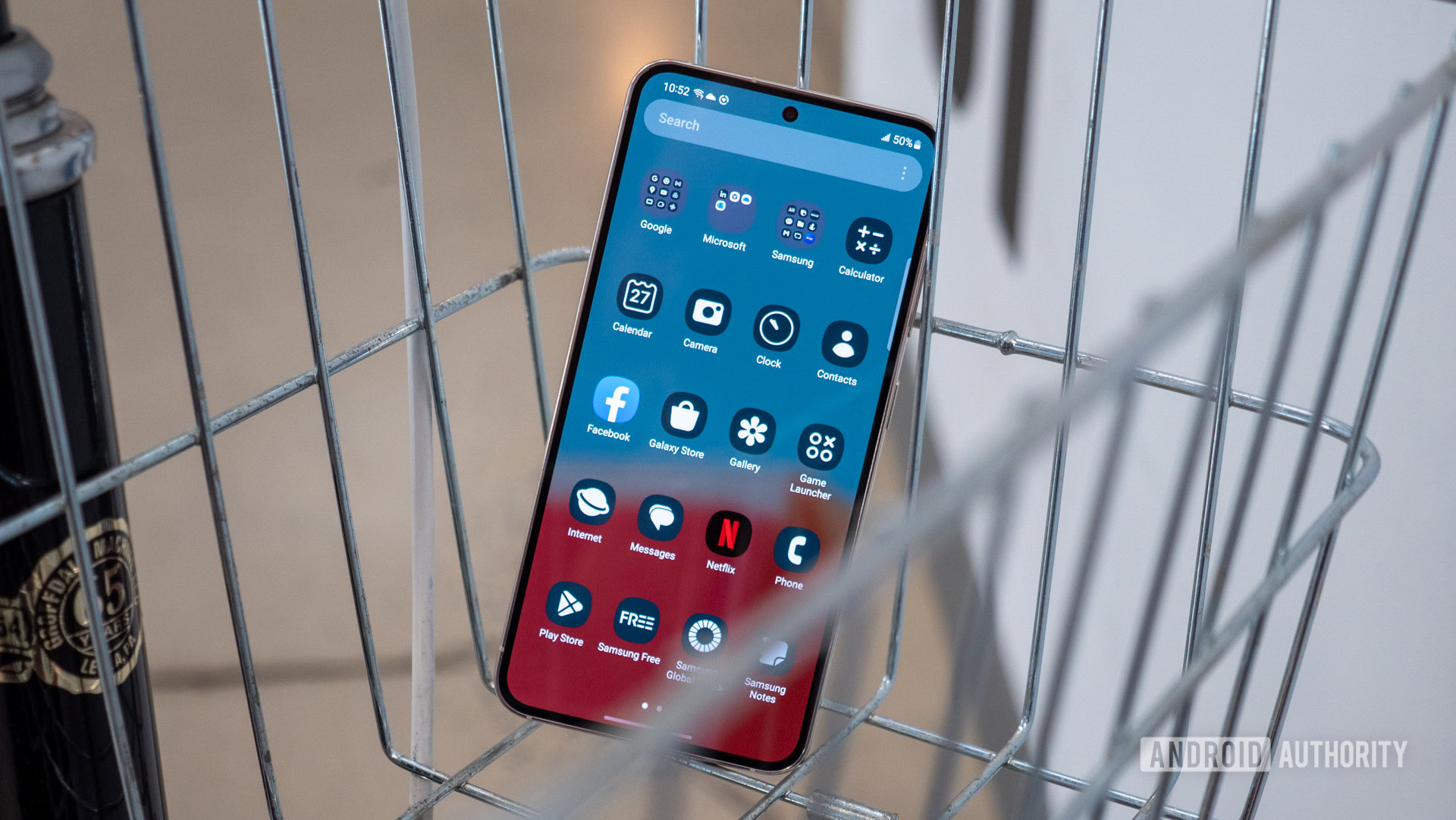
It’s not a spoiler to tell you that Mini Me doesn’t spend all of his time in Dr. Evil’s shadow during the Austin Powers trilogy (well, it is, but the movies are 20 years old and I’m being vague here!). Likewise, the Samsung Galaxy S23 isn’t relegated to a supporting role exclusively for small phone lovers. Its build quality is as good as ever, and the larger battery combines nicely with the more performant and more efficient Snapdragon 8 Gen 2 for Galaxy chipset as it powers through the day.
The Galaxy S23 will always be compared to its larger, more powerful siblings, but that's no reason for it to stand in their shadows.
Samsung’s software support is second to none in the Android world, and One UI has more customizations and wrinkles than ever while still not feeling like an overwhelming mess of menus and complications. If we have to pick a flaw with Samsung’s most pocketable device, it’s that 25W wired charging is still the go-to in the face of 45W speeds for its siblings, but as far as louder grumbles go, that’s about it. There’s the increasingly questionable value in markets like Europe, where the price increases make upper-mid-rangers even more palatable, but the Galaxy S23 remains a great buy in the US, especially with the Galaxy S24 now running about.
In the end, is the Samsung Galaxy S23 among the best, most complete small (or at least small-ish) Android phone you can buy? Yeah, baby, yeah.
Top Samsung Galaxy S23 questions and answers
The Samsung Galaxy S23 has an IP68 rating for water and dust resistance, which means it can be submerged in up to 1.5 meters of water for 30 minutes.
No, the Samsung Galaxy S23 comes with either 128 or 256GB of fixed storage and does not have a microSD card slot.
The main spec differences are that the Samsung Galaxy S23 has Qualcomm’s latest Snapdragon 8 Gen 2 processor instead of the Snapdragon 8 Gen 1 of its predecessor, as well as a slightly larger 3,900mAh battery. Read our in-depth Galaxy S22 vs Galaxy S23 comparison for more information.
The Samsung Galaxy S23 is set for four Android version updates and five years of security patches.
No, Samsung’s Galaxy S23 does not support the S Pen. Only the Galaxy S23 Ultra, which comes with a stylus built-in, supports it.
No, the Samsung Galaxy S23 does not have a headphone jack, though it does support Bluetooth 5.3 and Bluetooth LE for wireless connections.